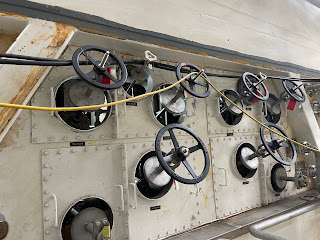管路測試
1. **水壓試驗:** 將管道注滿水或其他適當的液體,施加指定的壓力,以確保系統在不漏水的情況下能夠承受設計壓力。
2. **氣壓試驗:** 與水壓試驗類似,但使用空氣或慣性氣體代替水。有助於檢測漏洞並評估系統的結構完整性。
3. **漏測試驗:** 使用不同的方法,包括視覺檢查、壓力減少或質譜儀等,以識別和定位管道系統中的漏點。
4. **目視檢查:** 進行仔細的視覺檢查,檢查缺陷、正確的對齊、焊接質量以及管道和配件的整體狀況。
5. **染色滲透檢測:** 這是一種無損檢測方法,涉及在焊縫表面塗抹有色染料,讓其滲透到任何表面缺陷中。然後去除多餘的染料,並應用開發劑以顯示缺陷。
6. **射線檢測(X射線):** 使用X射線或伽馬射線檢查焊縫的內部結構,並識別可能在外部看不到的任何缺陷。
7. **超聲波檢測:** 使用高頻聲波來檢測材料的內部缺陷或間斷,提供有關管道壁的厚度和完整性的信息。
8. **磁粉檢測:** 這種技術通過在表面應用磁性顆粒來檢測表面和近表面的缺陷,從而使缺陷在檢查中可見。
9. **正向材料識別(PMI):** 通過X射線螢光或火花測試等技術,驗證管道系統中使用的材料是否符合指定的成分。
10. **硬度檢測:** 測量管道材料的硬度,確保其符合所需的規格並適用於預定的使用。
11. **假日測試:** 通常用於塗層管道,可識別塗層中的間斷或針孔,這可能導致腐蝕。
請記住,具體所需的測試會根據管道類型、使用的材料和相關行業標準或法規而有所不同。在項目中始終諮詢相關的代碼和指南以獲取具體要求。
1. **Hydrostatic Testing:** This involves filling the pipe with water or another suitable fluid and pressurizing it to a specified level to ensure the system can handle the design pressure without leakage.
2. **Pneumatic Testing:** Similar to hydrostatic testing, but air or an inert gas is used instead of water. It helps identify leaks and assess the system's structural integrity.
3. **Leak Testing:** Various methods, including visual inspection, pressure decay, or mass spectrometry, are used to identify and locate leaks in the piping system.
4. **Visual Inspection:** A thorough visual examination to check for defects, proper alignment, welding quality, and the overall condition of the pipes and fittings.
5. **Dye Penetrant Testing:** This non-destructive test involves applying a colored dye to the surface of the weld, allowing it to penetrate any surface defects. Excess dye is then removed, and a developer is applied to reveal indications.
6. **Radiographic Testing (X-ray):** This method uses X-rays or gamma rays to inspect the internal structure of welds and identify any defects that may not be visible externally.
7. **Ultrasonic Testing:** High-frequency sound waves are used to detect internal flaws or discontinuities in the material, providing information about the thickness and integrity of the pipe wall.
8. **Magnetic Particle Testing:** This technique identifies surface and near-surface flaws by applying magnetic particles to the surface. The particles gather at the location of any defects, making them visible for inspection.
9. **Positive Material Identification (PMI):** This verifies that the materials used in the piping system match the specified composition through techniques like X-ray fluorescence or spark testing.
10. **Hardness Testing:** Measures the hardness of the pipe material, ensuring it meets the required specifications and is suitable for the intended service.
11. **Holiday Testing:** Commonly used for coated pipes, it identifies discontinuities or pinholes in the coating that could lead to corrosion.
Remember, the specific tests required can vary based on the type of piping, materials used, and industry standards or regulations. Always consult relevant codes and guidelines for the specific requirements in your project.




























